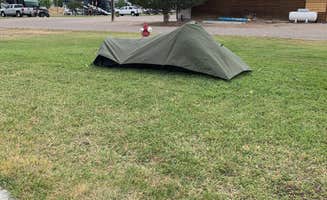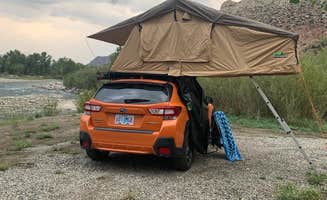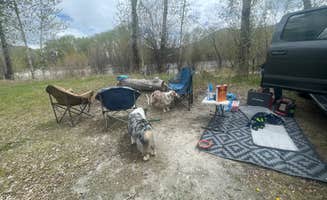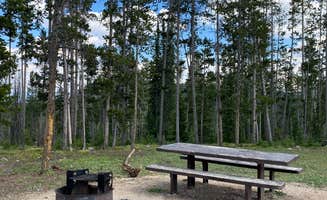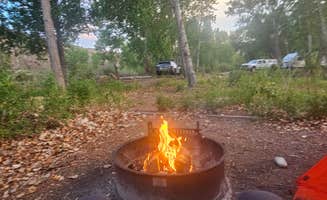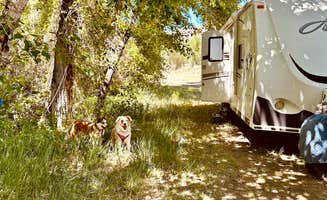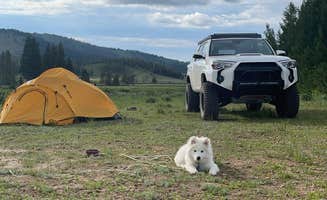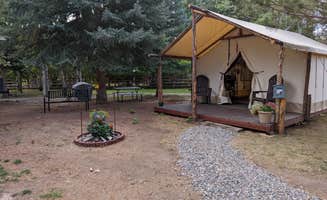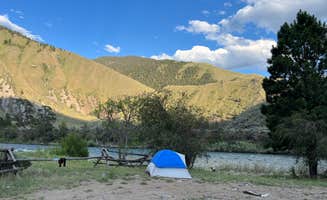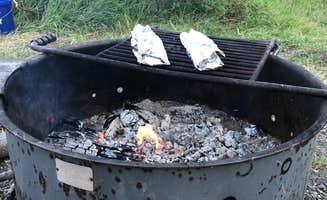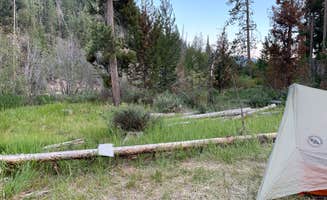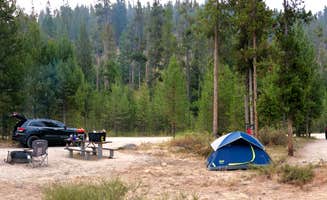Challis, Idaho sits at an elevation of 5,253 feet in the Salmon River Valley, surrounded by the Salmon-Challis National Forest. Summer temperatures often climb above 90°F during the day but drop significantly at night, creating challenging conditions for unprepared campers. Campsites near Challis, Idaho range from riverside locations to high mountain lakes, with most sites situated between 5,000-8,000 feet elevation.
What to do
Fishing in high mountain lakes: At Big Bayhorse, the fishing is particularly good for families. "Fishing was perfect for young boys that need to catch something frequently to keep them engaged. Caught 6 trout in the first hour," reports Beth B.
Visit the Bayhorse Ghost Town: Located on the road to Big Bayhorse Lake, this historical site makes for an interesting day trip. "Be sure to stop at the Bayhorse State Park Ghosttown. Really well preserved and they are doing more work to continue to preserve the old mining town," advises Annie C.
Explore on mountain bikes: The area offers numerous trails and country roads for cycling. At Challis Hot Springs, Karla B. suggests to "bring your mountain bike or running shoes for a relaxing ride or run on the country access roads."
Stargazing: With minimal light pollution, the night skies are exceptional. Nancy C. describes Deadman Hole as offering "serious star gazing opportunities," while Beth B. notes that at Big Bayhorse "the sky view at night was amazing... clear view of the Milky Way!"
What campers like
Hot springs access: Challis Hot Springs is highly rated for its natural hot pools. "This place is a true gem. Getting to experience hot springs without hiking to them is so nice," writes Luann. Another camper notes there are "two different hot pools from Hot springs" available to visitors.
Spacious campsites: Many camping spots near Challis offer good separation between sites. At Watts Bridge Campground, "The sites have picnic tables and grills and rock fire pits under a nice shady stand of cottonwoods," according to Annie C.
River proximity: Several campgrounds provide easy river access. At Deer Gulch, Ted T. notes there's a "Great view of the mountains and plenty of sites" right along the river, and Eric G. adds it's "a nice and convenient place to stop. Right along the Salmon river."
Clean facilities: Despite being remote, many campgrounds maintain good standards. At Cottonwood Recreation Site, a camper describes it as "a little gem with easy paved access and paved throughout. Just off the highway with good signage right on the Salmon River."
What you should know
Road conditions: Access to some campsites requires careful driving. The road to Big Bayhorse Lake can be challenging as Beth B. describes: "We made the drive up in our F-350 diesel and it felt sketchy in a few places. Took about 45 min. When we got to the top and saw others had towed their trailers up we were in shock."
Water availability: Bring extra water for remote sites. "We left early only because we didn't have enough water. Bring plenty for drinking and other daily uses!" advises Beth B. about camping at Big Bayhorse.
Cell reception: Connectivity varies greatly between camping areas. At Deadman Hole, Laura M. reports: "Zero cell reception ATT, verizon or TMobile. The WeBoost was able to give us bars of LTE but still was not very usable."
Highway noise: Campgrounds near the main roads can be noisy. Ted T. notes at Deer Gulch, "93 is close so there is some mild highway noise but nothing unbearable," while Laura M. says about Deadman Hole: "Though this campground sits along the highway it is easier to tolerate noise when its free!"
Tips for camping with families
Look for covered picnic tables: At Deadman Hole, covered tables provide shade during hot days. Nancy C. mentions the campground offers a "covered picnic table" among its amenities, which proves valuable with children.
Consider sites with playground access: Round Valley RV Park offers easy access to town amenities. Joshua P. notes, "It was walking distance to grocery store and gas station," making it convenient for families needing to restock supplies.
Find camping with shallow water access: For safer water play with children, choose sites with gentle river entry. At Watts Bridge, Sonya shares: "We walked to the other side of the bridge and let our dogs jump in where the water was calmer."
Watch for cottonwood fluff: During certain seasons, cottonwood trees shed extensively. Sonya warns about Watts Bridge: "The only thing that will prevent us from coming back is the cottonwood tree droppings. They're everywhere and very sticky, so if you have long haired dogs, it's a nightmare to get them out."
Tips from RVers
Check bridge clearance: Some camping areas have narrow access points. At Deer Gulch, Kenny R. advises: "Just off the main highway, and only a narrow bridge as an obstacle. There is currently a 30'ish foot big fifth wheel here, so I guess it can handle the weight. Just watch your sides if you are pulling a camper."
Look for pull-through sites: These make setup easier with larger rigs. At Cottonwood Recreation Site, Anne E. notes that of the 15 first-come, first-served sites, "2 of those are tent sites, 2 are pull thrus. The rest are back in with 7 of those being on the rivers edge."
Consider staying at established RV parks for hookups: When needing full services, Round Valley RV Park offers "Many large and well spaced pull through sites, all on gravel. Very little shade. Water, sewer and electric all good. Easy in and out," according to Christine.
Be cautious with sprinkler systems: Some campgrounds have irrigation that can surprise you. As Mack T. warns about Bayhorse Recreation Site: "There is a sprinkler system that randomly comes on all over the campground so be cautious of that. It scared the living crap out of us in the middle of the night."


